
| | You are here : Home > Museums > Fossils > How to Find Fossils How to Find Fossils | Where Are Fossils? | 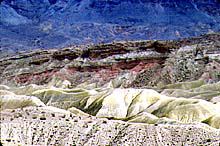
Sediments are deposited in layers, sometimes burying traces of life. These sedimentary rocks are stratified. | The oldest known fossils are 3.5 billion years old. What's happened in the past 3.5 billion years? The Earth is a very old place, and it's always changing: changing landscape, changing seas, changing weather, changing life. Every plant, every animal, every fungus, every bacterium eventually dies. Maybe it gets eaten, partly eaten, or it rots. If it gets buried and preserved, a fossil is formed. Wherever you are, you might be standing on a fossil. | | Clue #1: Remains or traces of life are preserved when they get buried, and protected from total destruction. Look for fossils where stuff might have been buried. Clue #2: Most fossils are found in sedimentary rock. (Sedimentary rocks are made of sand, silt, mud, or cobbles. Sediments are often carried in water, and deposited in layers or strata. Look for rock that is stratified. Not all sedimentary rock is hard.) Clue #3: Learn where you can find sedimentary rocks and how old they are. Ask your science teacher, go to the library, go to a science museum, join a geology club, look around and get dirty. |
| Where to Look for Fossils | 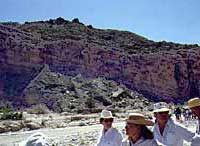
The slanting strata of these sedimentary rocks shows that these rocks have been uplifted. | Geologic forces of uplifting and erosion can reveal long-buried fossils. Major events of uplifting occur when two plates of land on the earth's surface crash into each other. One plate goes under; the other goes up. Many mountains are formed through uplifting. Erosion happens when water or wind wears away bits of rock. The Grand Canyon is a huge example of erosion. The Colorado River and dusty winds carved through the many layers of sedimentary rock, the different layers telling fossilized stories of life on Earth. The deepest layers tell the oldest stories, because they were deposited first. | 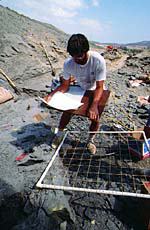
In the field: a paleontologist maps an excavation. | Clue #4: Look for areas where uplifting and erosion have exposed sedimentary rock. Explore mountains, bluffs, buttes, canyons, river banks, deserts, cliffs or eroded hillsides. The Bureau of Land Management oversees public lands where access and fossil hunting is allowed. Or, try looking in your own backyard (with proper clearance from a responsible adult). Be aware not to trespass on private property, and don't disturb protected lands in State and National Parks. |
| How to Look for Fossils | 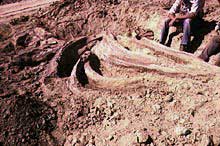
A Bowhead whale skull uncovered by wind and weather, and the careful work of expert fossil finders. | Looking for fossils can be like looking for a needle in a haystack. Knowing where to look narrows the field. Now, what do you look for? Remember fossils can be bones, leaves, footprints, any trace of ancient life. Clue #5: Look for unusual shapes and textures -- objects that are clearly different from the rock around them. - Take your time: work slowly and carefully when uncovering and cleaning fossils.
- Handle your find with care; it may be fragile.
- Take note of your location; you may have made an important discovery.
| 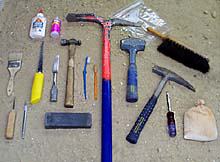 | Fossil finding tools are neither fancy nor expensive. Shown here are typical tools for a paleontologist in the field. A butterknife and a toothbrush may be all you need. |
| Discover What You Have | 
Fossil bones from an extinct sea cow on exhibit at the San Diego Natural History Museum. | Once you have found a fossil, the detective work is not over. Paleontologists use living things for comparison to help them discover the identity of fossil material. They also draw upon the work of others as they interpret the fossil evidence. Keeping a notebook is very important. Write down where you found your fossil and what type of rock it was found in. Remember, fossils are like words in a book, and the rock layers are the pages. | 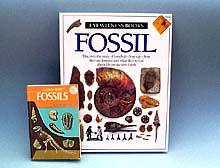 Books are an excellent way to learn about fossils, and to help identify fossils. Both of these are excellent resources. | Clue #6: Dig into a fossil field guide. A good book may prove very helpful when identifying your fossil. Clue #7: Visit a museum and compare your find to fossils, skeletons, or other objects on exhibit. Clue #8:Talk to a paleontologist at a museum or university. Perhaps they'll learn something from you! | | If you find something really unique, tell somebody: your parents, science teacher, librarian, or a paleontologist. Recently, a three-year old boy uncovered the first dinosaur egg fragments to be found in New Mexico. Now, they are in a museum where they can be studied and appreciated by people now and in the future. |
|

